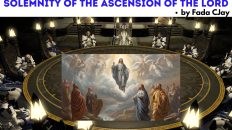ON THE
DOCTRINE OF THE IMMACULATE CONCEPTION OF THE BLESSED VIRGIN MARY
(MISCONCEPTIONS, CLARIFICATIONS AND BIBLICAL JUSTIFICATIONS)
DOCTRINE OF THE IMMACULATE CONCEPTION OF THE BLESSED VIRGIN MARY
(MISCONCEPTIONS, CLARIFICATIONS AND BIBLICAL JUSTIFICATIONS)
“We declare, pronounce, and define that the doctrine which holds that the
most Blessed Virgin Mary, in the first instance of her conception, by a
singular grace and privilege granted by Almighty God, in view of the merits of
Jesus Christ, the Saviour of the human race, was preserved free from all stain
of original sin, is a doctrine revealed by God and therefore to be believed
firmly and constantly by all the faithful.” (-Apostolic Constitution of Pope Pius
IX solemnly defining the dogma of the Immaulate Conception, 8 December 1854.)
From the foregoing, we understand
that the “Immaculate Conception” simply means that Mary, whose
conception was brought about the normal way, was conceived without original sin
or its stain—that’s what “immaculate” means: without stain- immaculate. Thus,
by affirming that Mary was conceived without Original sin, it follows then,
that She did not commit any sin during her lifetime on earth. We shall come to
understand this before the end of this post.
that the “Immaculate Conception” simply means that Mary, whose
conception was brought about the normal way, was conceived without original sin
or its stain—that’s what “immaculate” means: without stain- immaculate. Thus,
by affirming that Mary was conceived without Original sin, it follows then,
that She did not commit any sin during her lifetime on earth. We shall come to
understand this before the end of this post.
The essence of
original sin consists in the deprivation of sanctifying grace, and its stain is
a corrupt nature. Mary was preserved from these defects by God’s grace; from
the first instant of her existence she was in the state of sanctifying grace
and was free from the corrupt nature original sin brings. When discussing the
Immaculate Conception, an implicit reference may be found in the angel’s
greeting to Mary. The angel Gabriel said, “HAIL, FULL OF GRACE, THE LORD IS
WITH YOU” (Luke 1:28). The phrase “FULL OF GRACE” is a translation of the Greek
word: “KECHARITOMENE”, which therefore, expresses a characteristic
quality of Mary.
original sin consists in the deprivation of sanctifying grace, and its stain is
a corrupt nature. Mary was preserved from these defects by God’s grace; from
the first instant of her existence she was in the state of sanctifying grace
and was free from the corrupt nature original sin brings. When discussing the
Immaculate Conception, an implicit reference may be found in the angel’s
greeting to Mary. The angel Gabriel said, “HAIL, FULL OF GRACE, THE LORD IS
WITH YOU” (Luke 1:28). The phrase “FULL OF GRACE” is a translation of the Greek
word: “KECHARITOMENE”, which therefore, expresses a characteristic
quality of Mary.
The traditional
translation, “full of grace,” is interpreted in a different way in many recent
versions of the New Testament, which give something along the lines of “HIGHLY
FAVOURED DAUGHTER.” Since the New Testament was originally written in Greek,
the expression of the angel in Greek (KECHARITOMENE) never mentions the word
for “daughter”, it simply means FULL OF GRACE. Nevertheless, going by the
translation of the recent versons of today’s Bibles, we can still see that Mary
is indeed a highly favoured daughter of God, and the question is: “how can
one who’s highly favoured by God be exposed to the corruption of original sin?”
Indeed, the highly favoured one must be an EXCEPTION to the phrase: “for
all have sinned and fallen short of God’s grace…” (Rom. 3:23).
translation, “full of grace,” is interpreted in a different way in many recent
versions of the New Testament, which give something along the lines of “HIGHLY
FAVOURED DAUGHTER.” Since the New Testament was originally written in Greek,
the expression of the angel in Greek (KECHARITOMENE) never mentions the word
for “daughter”, it simply means FULL OF GRACE. Nevertheless, going by the
translation of the recent versons of today’s Bibles, we can still see that Mary
is indeed a highly favoured daughter of God, and the question is: “how can
one who’s highly favoured by God be exposed to the corruption of original sin?”
Indeed, the highly favoured one must be an EXCEPTION to the phrase: “for
all have sinned and fallen short of God’s grace…” (Rom. 3:23).
The grace given to
Mary is at once permanent and of a unique kind. In Greek, Kecharitomene is a
perfect passive participle of charitoo , meaning “to fill or endow with Grace.”
Since this term is in the perfect tense, it indicates that Mary was graced in
the past and with continuing effects in the present. So, the grace Mary enjoyed
was not a result of the angel’s visit. In fact, the Church holds, it extended
over the whole of her life, from conception onward. She was in a state of
sanctifying grace from the first moment of her existence, because she has been
choosen even before she was born.
Mary is at once permanent and of a unique kind. In Greek, Kecharitomene is a
perfect passive participle of charitoo , meaning “to fill or endow with Grace.”
Since this term is in the perfect tense, it indicates that Mary was graced in
the past and with continuing effects in the present. So, the grace Mary enjoyed
was not a result of the angel’s visit. In fact, the Church holds, it extended
over the whole of her life, from conception onward. She was in a state of
sanctifying grace from the first moment of her existence, because she has been
choosen even before she was born.
Let us consider the
claims of our separated brethren:
claims of our separated brethren:
PROTESTANTS’ (Fundamentalist) OBJECTION
I remembered having a discussion
some time ago with some colleagues (protestants) and according to them, their
reason for objecting to the Immaculate Conception and Mary’s consequent sinlessness
is that we are told that “all have sinned” (Rom. 3:23).
Besides, they said, Mary said her “spirit rejoices in God my Saviour” (Luke
1:47), and only a sinner needs a Saviour.
some time ago with some colleagues (protestants) and according to them, their
reason for objecting to the Immaculate Conception and Mary’s consequent sinlessness
is that we are told that “all have sinned” (Rom. 3:23).
Besides, they said, Mary said her “spirit rejoices in God my Saviour” (Luke
1:47), and only a sinner needs a Saviour.
Let’s take the second
citation first. Indeed Mary, too, required a Saviour. Like all other
descendants of Adam, she was subject to the necessity of contracting original
sin. But by a special intervention of God, undertaken at the instant she was
conceived, she was preserved from the stain of original sin and its
consequences. She was therefore redeemed by the grace of Christ, but in a
special way—by anticipation…
citation first. Indeed Mary, too, required a Saviour. Like all other
descendants of Adam, she was subject to the necessity of contracting original
sin. But by a special intervention of God, undertaken at the instant she was
conceived, she was preserved from the stain of original sin and its
consequences. She was therefore redeemed by the grace of Christ, but in a
special way—by anticipation…
CONSIDER AN ANALOGY
Suppose a man falls into a deep
pit, and someone reaches down to pull him out. The man has been “saved” from
the pit. Now imagine a woman walking along, and she too is about to topple into
the pit, but at the very moment that she is to fall in, someone holds her back
and prevents her. She too has been saved from the pit, but in an even better
way: She was not simply taken out of the pit, she was prevented from getting
stained by the mud in the first place; hence she would be more grateful; and
this signifies the person of the Blessed Virgin Mary. Little wonder she says: “MY
SPIRIT REJOICES IN GOD MY SAVIOUR… THE ALMIGHTY HAS DONE “GREAT”
THINGS FOR ME…” (Luke 1:47ff)
pit, and someone reaches down to pull him out. The man has been “saved” from
the pit. Now imagine a woman walking along, and she too is about to topple into
the pit, but at the very moment that she is to fall in, someone holds her back
and prevents her. She too has been saved from the pit, but in an even better
way: She was not simply taken out of the pit, she was prevented from getting
stained by the mud in the first place; hence she would be more grateful; and
this signifies the person of the Blessed Virgin Mary. Little wonder she says: “MY
SPIRIT REJOICES IN GOD MY SAVIOUR… THE ALMIGHTY HAS DONE “GREAT”
THINGS FOR ME…” (Luke 1:47ff)
The Catechism of the
Catholic Church states that she was “redeemed in a more exalted fashion, by
reason of the merits of her Son” (CCC 492). She has more reason to call God her
Saviour than we do, because he saved her in an even more glorious manner…
Catholic Church states that she was “redeemed in a more exalted fashion, by
reason of the merits of her Son” (CCC 492). She has more reason to call God her
Saviour than we do, because he saved her in an even more glorious manner…
BACK TO THE FIRST
OBJECTION:
OBJECTION:
But what about Romans 3:23, “all
have sinned”?
have sinned”?
We should have it in mind that
there are two types of sins: Original sin and Actual sin. Original sin is the
sin we all inherited from our first parents (Adam and Eve), which is
necessarily washed away by our Baptism. While Actual sin means the sins we
commit in our day to day lives. It is true that if Adam and Eve had not
committed the Original sin, we won’t be sinners today; because the Original sin
infuses “concupiscence” (the tendency to often commit sin) in every
man. Thus, the Original sin gave way for Actual sin. Having exposed this, and
following the syllogism of the point above, we can say that since Mary was
preserved from ORIGINAL SIN, it also implies that she did not commit an ACTUAL
SIN.
there are two types of sins: Original sin and Actual sin. Original sin is the
sin we all inherited from our first parents (Adam and Eve), which is
necessarily washed away by our Baptism. While Actual sin means the sins we
commit in our day to day lives. It is true that if Adam and Eve had not
committed the Original sin, we won’t be sinners today; because the Original sin
infuses “concupiscence” (the tendency to often commit sin) in every
man. Thus, the Original sin gave way for Actual sin. Having exposed this, and
following the syllogism of the point above, we can say that since Mary was
preserved from ORIGINAL SIN, it also implies that she did not commit an ACTUAL
SIN.
As a follow up,
Looking at the phrase “All have sinned”, the first question that arises from
the objection “all have sinned” is: Have all people committed actual
sins? (Our day to day sins) The answer is No!!! This is indicated in St. Paul
in the letter to the Romans when he speaks of the time when Jacob and Esau were
unborn babies as a time when they “had done nothing either good or bad”
(Rom.9:11). This is so because a child below the age of reason by definition he
can’t sin, since sinning requires the ability to reason and the ability to
intend to sin. Notwithstanding, the idea is that we’re all sinners. Therefore,
the term “all” is used to refer to the MAJORITY.
Looking at the phrase “All have sinned”, the first question that arises from
the objection “all have sinned” is: Have all people committed actual
sins? (Our day to day sins) The answer is No!!! This is indicated in St. Paul
in the letter to the Romans when he speaks of the time when Jacob and Esau were
unborn babies as a time when they “had done nothing either good or bad”
(Rom.9:11). This is so because a child below the age of reason by definition he
can’t sin, since sinning requires the ability to reason and the ability to
intend to sin. Notwithstanding, the idea is that we’re all sinners. Therefore,
the term “all” is used to refer to the MAJORITY.
The 2nd question is:
What of original sin?
What of original sin?
We Christians all know that a
very prominent exception to the rule is Christ Jesus (Heb. 4:15). So if Paul’s
statement in Romans 3 includes an exception for the New Adam (Jesus), one may
argue that an exception for the New Eve (Mary) can also be made. HOW IS THIS POSSIBLE?
This is because the Blessed Virgin Mary is referred by God through the Angel
Gabriel as “Full of Grace” (highly favoured one) in Luke 1:28. No
other person in the Scriptures has been referred to as full of Grace except
Christ Jesus (cf. John 1:14—-” The Word became flesh and made his
dwelling among us. We have seen his glory, the glory of the one and only Son,
who came from the Father, FULL OF GRACE AND TRUTH). Besides, the Scriptures
make us to realize that Adam and Eve lost the grace of God by committing sin.
Sin is the absence of God’s Grace. Paul makes this clearer in Romans 5:20:
“Where sin increases, Grace abounds all the more…”
Hence we have only Our Lord Jesus Christ and the Blessed Virgin Mary in the
Scriptures who are referred to as full of Grace (New Adam and the New Eve)
without the stain of SIN. However, since Christ Jesus and his Blessed Mother
are without original sin, then it logically implies that they also did not
commit actual sins. (Since original sin makes one commit actual sins).
very prominent exception to the rule is Christ Jesus (Heb. 4:15). So if Paul’s
statement in Romans 3 includes an exception for the New Adam (Jesus), one may
argue that an exception for the New Eve (Mary) can also be made. HOW IS THIS POSSIBLE?
This is because the Blessed Virgin Mary is referred by God through the Angel
Gabriel as “Full of Grace” (highly favoured one) in Luke 1:28. No
other person in the Scriptures has been referred to as full of Grace except
Christ Jesus (cf. John 1:14—-” The Word became flesh and made his
dwelling among us. We have seen his glory, the glory of the one and only Son,
who came from the Father, FULL OF GRACE AND TRUTH). Besides, the Scriptures
make us to realize that Adam and Eve lost the grace of God by committing sin.
Sin is the absence of God’s Grace. Paul makes this clearer in Romans 5:20:
“Where sin increases, Grace abounds all the more…”
Hence we have only Our Lord Jesus Christ and the Blessed Virgin Mary in the
Scriptures who are referred to as full of Grace (New Adam and the New Eve)
without the stain of SIN. However, since Christ Jesus and his Blessed Mother
are without original sin, then it logically implies that they also did not
commit actual sins. (Since original sin makes one commit actual sins).
ANOTHER PROOF FROM THE SCRIPTURES CAN BE FOUND IN
GENESIS 3:15:
“And God said to the serpent ‘I will put enmity between you and the woman,
between your seed and hers; It will crush your head while you strike at it’s
heel.'”
WHAT DOES THE BOOK OF GENESIS HAVE TO DO
WITH MARY’S IMMACULATE CONCEPTION?
GENESIS 3:15:
“And God said to the serpent ‘I will put enmity between you and the woman,
between your seed and hers; It will crush your head while you strike at it’s
heel.'”
WHAT DOES THE BOOK OF GENESIS HAVE TO DO
WITH MARY’S IMMACULATE CONCEPTION?
Genesis 3:15 is the first passage
in the Bible that refers to Jesus defeating Satan on the cross. It is also the
first verse that shows us how Mary would become the New Eve. The Seed of the
“Woman”, who would crush the serpent’s head, is Jesus. The Woman at
enmity, or hostility with the serpent, is Mary. It was God who put this
hostility between Mary and Satan (the serpent), and it is believed to be in the
same likeness as Christ’s hostility for the seed of the serpent.
WHAT EXACTLY DOES ALL THIS MEAN? For Mary to be like Christ in His hostility
for Satan forever, it is very possible to say that this passage implies Mary’s
lack of sin. What better way is there to be in total hostility with Satan than
to be in God’s constant grace.. As the New Eve, Mary undid the “No”
of the Old Testament Eve by saying, “YES” to bear Jesus. Therefore,
how can someone who’s in enmity with Satan be with sin, since sin is of Satan? IMPOSSIBLE!!!
in the Bible that refers to Jesus defeating Satan on the cross. It is also the
first verse that shows us how Mary would become the New Eve. The Seed of the
“Woman”, who would crush the serpent’s head, is Jesus. The Woman at
enmity, or hostility with the serpent, is Mary. It was God who put this
hostility between Mary and Satan (the serpent), and it is believed to be in the
same likeness as Christ’s hostility for the seed of the serpent.
WHAT EXACTLY DOES ALL THIS MEAN? For Mary to be like Christ in His hostility
for Satan forever, it is very possible to say that this passage implies Mary’s
lack of sin. What better way is there to be in total hostility with Satan than
to be in God’s constant grace.. As the New Eve, Mary undid the “No”
of the Old Testament Eve by saying, “YES” to bear Jesus. Therefore,
how can someone who’s in enmity with Satan be with sin, since sin is of Satan? IMPOSSIBLE!!!
A confusion that may
arise here is: if Mary were without sin, then, she would be equal to God. In
the beginning, God created Adam, Eve, and the angels without sin, but none were
equal to God? Most of the angels never sinned, and all souls in heaven are
without sin. This does not detract from the glory of God, but manifests it by
the work he has done in sanctifying his creation. Sinning does not make one
human. On the contrary, it is when man is without sin that he is most fully
what God intends him to be.
arise here is: if Mary were without sin, then, she would be equal to God. In
the beginning, God created Adam, Eve, and the angels without sin, but none were
equal to God? Most of the angels never sinned, and all souls in heaven are
without sin. This does not detract from the glory of God, but manifests it by
the work he has done in sanctifying his creation. Sinning does not make one
human. On the contrary, it is when man is without sin that he is most fully
what God intends him to be.
Importantly, On
Thursday, 25th March, 1858, Bernadette of Lourdes (a city in France) recounted
the apparition of the Virgin Mary and what she heard from her. According to
Bernadette, “the Lady lifted up her eyes to heaven, joined her hands as
though in prayer, that were held out and open towards the ground and said to
me: ‘Que soy era Immaculada Concepciou…’ (I am the Immaculate Conception)
.” The young visionary left and, running all the way, repeated
continuously the words that she did not understand. These words troubled the
brave Parish Priest. Bernadette was ignorant of the fact that this theological
expression was assigned to the Blessed Virgin four years earlier, in 1854, Pope
Pius IX declared this a truth of the Catholic Faith (a dogma).
Thursday, 25th March, 1858, Bernadette of Lourdes (a city in France) recounted
the apparition of the Virgin Mary and what she heard from her. According to
Bernadette, “the Lady lifted up her eyes to heaven, joined her hands as
though in prayer, that were held out and open towards the ground and said to
me: ‘Que soy era Immaculada Concepciou…’ (I am the Immaculate Conception)
.” The young visionary left and, running all the way, repeated
continuously the words that she did not understand. These words troubled the
brave Parish Priest. Bernadette was ignorant of the fact that this theological
expression was assigned to the Blessed Virgin four years earlier, in 1854, Pope
Pius IX declared this a truth of the Catholic Faith (a dogma).
CONCLUSION
It was Mary’s closeness to Christ that made her receive God’s “fullness of
grace” to be sinless. Without God’s grace, it would have been impossible
for Mary to be sinless. The Holy Spirit even declared her blessedness from the
lips of Elizabeth during the visitation scene “Blessed are you among all
women and blessed it the fruit of your womb” (Luke 1:42).
The conclusion is inescapable, how can someone who is blessed among all women
and chosen by God to bring forth His Son (holy of holies) be in contact with
the stain of sin? Besides, a bad tree cannot produce good fruits, it is only a
good tree that produces good fruits – according to Christ himself (cf. Matthew
7:17-18; Luke 6:43)
It was Mary’s closeness to Christ that made her receive God’s “fullness of
grace” to be sinless. Without God’s grace, it would have been impossible
for Mary to be sinless. The Holy Spirit even declared her blessedness from the
lips of Elizabeth during the visitation scene “Blessed are you among all
women and blessed it the fruit of your womb” (Luke 1:42).
The conclusion is inescapable, how can someone who is blessed among all women
and chosen by God to bring forth His Son (holy of holies) be in contact with
the stain of sin? Besides, a bad tree cannot produce good fruits, it is only a
good tree that produces good fruits – according to Christ himself (cf. Matthew
7:17-18; Luke 6:43)




